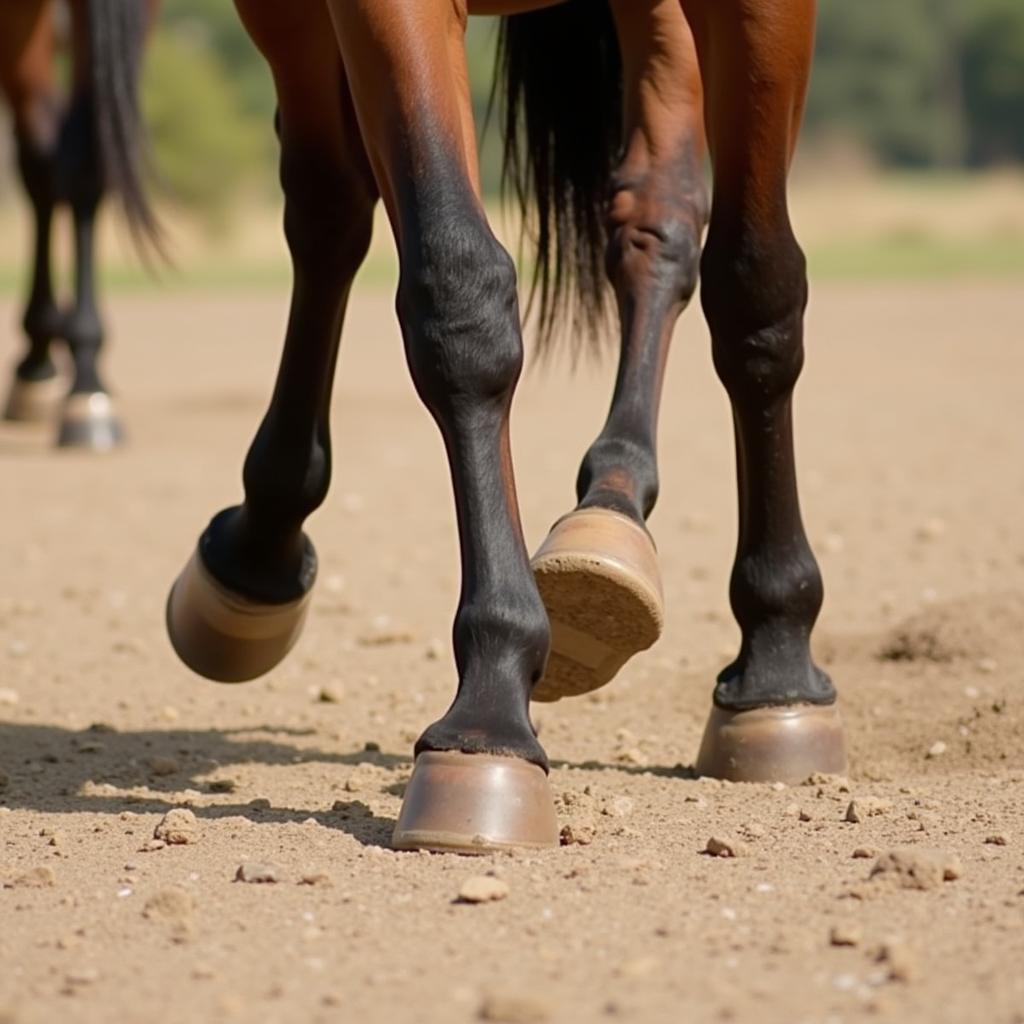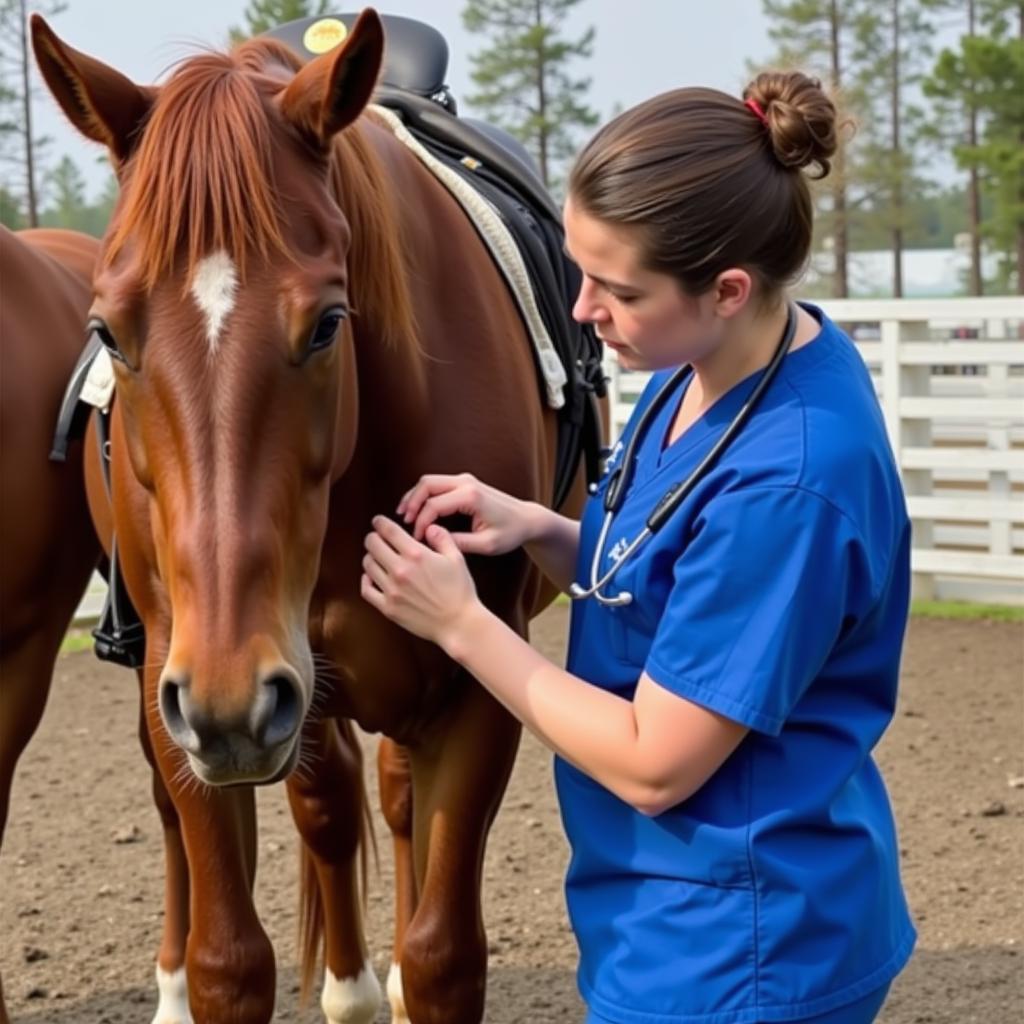The “Horse Paddle,” a term you might have heard tossed around the stables or online forums, doesn’t actually refer to horses swimming. It’s a colloquial term used to describe a specific gait abnormality seen in some horses. While it might sound intriguing, the horse paddle can be a sign of underlying health or conformational issues.
What Exactly is the Horse Paddle?
The horse paddle refers to a horse’s tendency to swing its front legs outward in a circular motion, resembling the action of a paddle, during movement. This abnormal gait deviation typically occurs when the horse is trotting or cantering, and is most noticeable in the front limbs. Instead of moving in a straight line, the horse’s legs swing outward in an arc before landing.
 Horse Paddling Gait Abnormality
Horse Paddling Gait Abnormality
Causes of the Horse Paddle
Understanding the potential causes of horse paddling is crucial for proper diagnosis and management. Some common factors include:
- Conformation: A horse’s natural build, particularly narrow chests, toeing-in, or base-narrow stances, can predispose them to paddling.
- Neurological Issues: In some cases, paddling can be a symptom of a neurological disorder affecting the horse’s coordination and movement.
- Muscle Weakness or Imbalance: Weak or imbalanced muscles, particularly in the shoulders or forelegs, can contribute to an uneven gait and paddling.
- Pain or Injury: Horses experiencing pain from conditions like arthritis, laminitis, or abscesses may adopt an abnormal gait like paddling to alleviate discomfort.
- Improper Shoeing: Incorrect shoeing can alter a horse’s natural footfall and potentially lead to paddling.
Identifying the Horse Paddle
Recognizing the horse paddle involves careful observation of your horse’s movement. Look for these telltale signs:
- Outward Swinging of the Forelegs: The most obvious indicator is the distinctive circular motion of the horse’s front legs when moving.
- Uneven Footfalls: Listen for an uneven rhythm in the horse’s footfalls, as the paddling motion can disrupt the normal sequence.
- Head Bobbing: Some horses may bob their heads in an attempt to compensate for the imbalance caused by paddling.
 Veterinarian Examining Horse for Paddling
Veterinarian Examining Horse for Paddling
Managing the Horse Paddle
Addressing the horse paddle effectively requires identifying the underlying cause. Here are some potential management strategies:
- Veterinary Evaluation: A thorough veterinary examination is crucial to diagnose any underlying medical conditions and rule out serious concerns.
- Corrective Shoeing: A qualified farrier can assess the horse’s hoof balance and apply corrective shoeing techniques to improve gait and minimize paddling.
- Physical Therapy: Targeted exercises and therapies can help strengthen muscles, improve flexibility, and enhance coordination.
- Pain Management: If pain is a contributing factor, your veterinarian may recommend medications or other therapies to alleviate discomfort and improve mobility.
- Conformation Management: While you cannot change a horse’s conformation, you can manage its workload and exercise regimen to minimize stress on its joints and limbs.
When to Seek Professional Help
If you notice any signs of paddling in your horse, it’s crucial to consult your veterinarian. Early diagnosis and intervention can significantly improve the horse’s long-term prognosis and potentially prevent further complications.
white horse beach plymouth ma rentals
Frequently Asked Questions about Horse Paddling
Q: Can horse paddling be cured?
A: The potential for “curing” horse paddling depends entirely on the underlying cause. Some cases, especially those related to muscle weakness or improper shoeing, can be effectively managed with appropriate therapies. However, if the paddling is due to a horse’s conformation or a neurological condition, complete resolution might not be possible.
Q: Is horse paddling painful for the horse?
A: While paddling itself might not be inherently painful, it can be a symptom of an underlying condition that is causing discomfort, such as arthritis or laminitis. If your horse is paddling, it’s important to have it examined by a veterinarian to rule out any painful conditions.
Q: Can I still ride a horse that paddles?
A: The suitability of riding a horse that paddles depends on the severity of the paddling and the underlying cause. In some cases, light riding might be possible with appropriate management strategies in place. However, it’s essential to consult with your veterinarian to determine what’s best for your horse’s well-being.
Q: Can horse paddling be prevented?
A: While not all causes of paddling are preventable, some measures, such as ensuring proper hoof care, maintaining a balanced exercise program, and addressing any signs of pain or lameness promptly, can help reduce the risk.
Need More Information?
For more insightful articles on equine health and well-being, visit horse tack auction.
Contact Us
Need help with your equine companion? Contact us at Phone Number: 0772127271, Email: [email protected] Or visit us at: QGM2+WX2, Vị Trung, Vị Thuỷ, Hậu Giang, Việt Nam. Our dedicated customer support team is available 24/7.